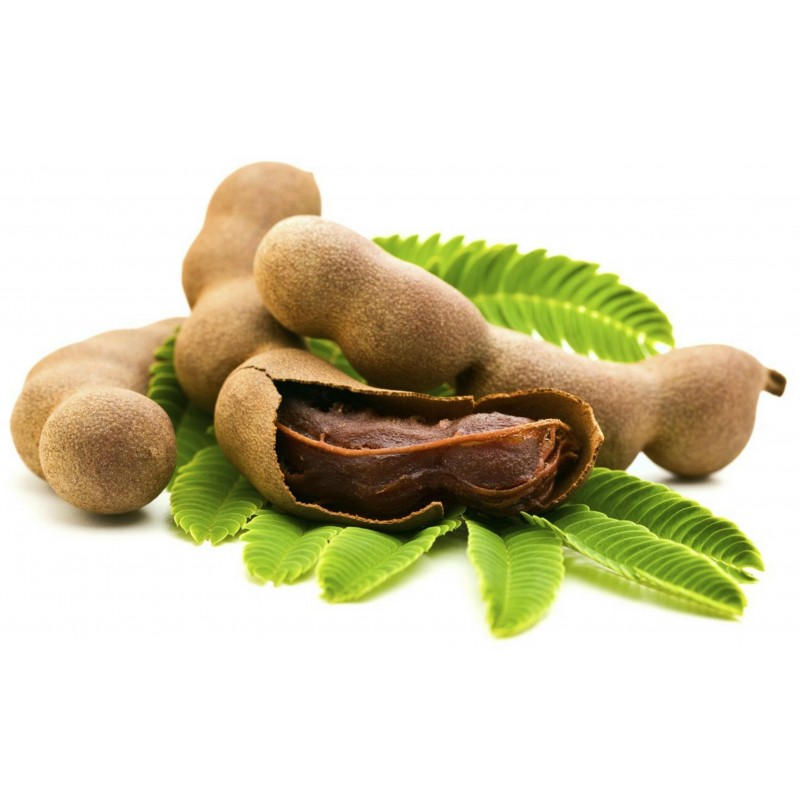Tamarind Seeds (Tamarindus indica)
Price for Package of 5 seeds.
The tamarind is a long-lived, medium-growth, bushy tree which attains a maximum crown height of 12.1 to 18.3 metres (40 to 60 feet). The crown has an irregular, vase-shaped outline of dense foliage. The tree grows well in full sun in clay, loam, sandy, and acidic soil types, with high drought and aerosol salt (wind-borne salt as found in the coastal area) resistance.
Leaves are evergreen, bright green in colour, an elliptical ovular, arrangement is alternate, of the pinnately compound type, with pinnate venation and less than 5 cm (2 inches) in length. The branches droop from a single, central trunk as the tree matures and is often pruned in human agriculture to optimize tree density and ease of fruit harvest. At night, the leaflets close up.
The tamarind does flower, though inconspicuously, with red and yellow elongated flowers. Flowers are 2.5 cm wide (one inch), five-petalled, borne in small racemes, and yellow with orange or red streaks. Buds are pink as the four sepals are pink and are lost when the flower blooms.
The fruit is an indehiscent legume, sometimes called a pod, 12 to 15 cm (3 to 6 inches) in length, with a hard, brown shell.The fruit has a fleshy, juicy, acidulous pulp. It is mature when the flesh is coloured brown or reddish-brown. The tamarinds of Asia have longer pods containing six to 12 seeds, whereas African and West Indian varieties have short pods containing one to six seeds. The seeds are somewhat flattened, and glossy brown.
The tamarind is best described as sweet and sour in taste, and is high in acid, sugar, B vitamins and, interestingly for a fruit, calcium.
As a tropical species, it is frost sensitive. The pinnate leaves with opposite leaflets give a billowing effect in the wind. Tamarind timber consists of hard, dark red heartwood and softer, yellowish sapwood.
Tamarind is harvested by pulling the pod from its stalk. A mature tree may be capable of producing up to 175 kg (350 lb) of fruit per year
Care:
Soil:
The tree tolerates clay, silt, sand, and acid soils with high drought and salt air.
Exposure:
Full sun.
Water:
Water regularly. Although the tree is drought resistant, it will drop its leaves after a prolonged drought.
Fertilizer:
Young trees: every 2-3 months with 6-6-3 NPK.
Older, fruit-bearing trees: 3-4 times per year with 8-3-9 NPK
Propagation:
From seed. Only the large brown seeds from fresh, ripe pods are viable. The seeds maintain their viability 3-4 years on condition that they kept are in a dry box.
scarify the seeds or boil them for 30 minutes in water at 100 °C and plunge them in a cold bath to stop the heating. Both procedures provide better water absorption by the seed and increase the germination rate to about 95% by breaking down the hard shell.
plant the seeds in a light mix, in high containers (a deep taproot develops early on)
mist the substrate so that it is damp, not wet
cover the pots to prevent evaporation
20-25 °C (68-77 °F)
germination time: 7-10 days
protect the seedlings from direct sunlight until they are at least 30 cm (1′) high
be careful when transplanting, the roots do not tolerate damage
|
Sowing Instructions
|
|
Propagation:
|
Seeds
|
|
Pretreat:
|
pour hot water + soak about 24-48 hrs
|
|
Stratification:
|
0
|
|
Sowing Time:
|
all year round
|
|
Sowing Depth:
|
1 cm
|
|
Sowing Mix:
|
Coir or sowing mix + sand or perlite
|
|
Germination temperature:
|
25-28 ° C
|
|
Location:
|
bright + keep constantly moist not wet
|
|
Germination Time:
|
2-4 Weeks
|
|
Watering:
|
Water regularly during the growing season
|
|
|
Copyright © 2012 Seeds Gallery - Saatgut Galerie - Galerija semena. All Rights Reserved.
|
Winter: Older specimens light at about 5-10 ° C, and only so much water that the root ball does not dry out completely. Freezing temperatures can be tolerated for a short time!







 Reviews (1)
Reviews (1)